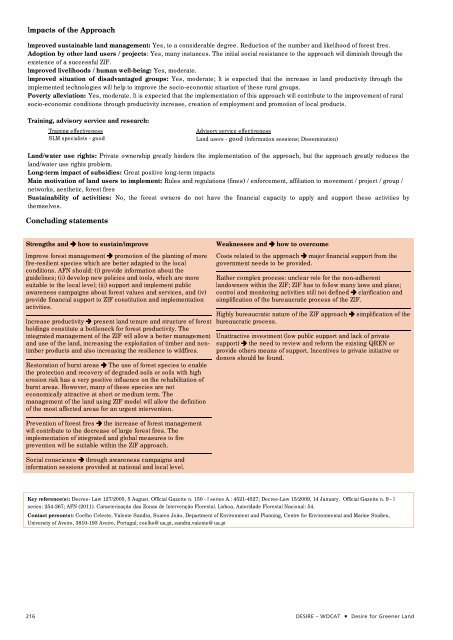Desire for Greener Land
Desire for Greener Land
Desire for Greener Land
Create successful ePaper yourself
Turn your PDF publications into a flip-book with our unique Google optimized e-Paper software.
Impacts of the Approach<br />
Improved sustainable land management: Yes, to a considerable degree. Reduction of the number and likelihood of <strong>for</strong>est fires.<br />
Adoption by other land users / projects: Yes, many instances. The initial social resistance to the approach will diminish through the<br />
existence of a successful ZIF.<br />
Improved livelihoods / human well-being: Yes, moderate.<br />
Improved situation of disadvantaged groups: Yes, moderate; It is expected that the increase in land productivity through the<br />
implemented technologies will help to improve the socio-economic situation of these rural groups.<br />
Poverty alleviation: Yes, moderate. It is expected that the implementation of this approach will contribute to the improvement of rural<br />
socio-economic conditions through productivity increase, creation of employment and promotion of local products.<br />
Training, advisory service and research:<br />
Training effectiveness<br />
SLM specialists - good<br />
Advisory service effectiveness<br />
<strong>Land</strong> users - good (In<strong>for</strong>mation sessions; Dissemination)<br />
<strong>Land</strong>/water use rights: Private ownership greatly hinders the implementation of the approach, but the approach greatly reduces the<br />
land/water use rights problem.<br />
Long-term impact of subsidies: Great positive long-term impacts<br />
Main motivation of land users to implement: Rules and regulations (fines) / en<strong>for</strong>cement, affiliation to movement / project / group /<br />
networks, aesthetic, <strong>for</strong>est fires<br />
Sustainability of activities: No, the <strong>for</strong>est owners do not have the financial capacity to apply and support these activities by<br />
themselves.<br />
Concluding statements<br />
Strengths and how to sustain/improve Weaknesses and how to overcome<br />
Improve <strong>for</strong>est management promotion of the planting of more<br />
fire-resilient species which are better adapted to the local<br />
conditions. AFN should: (i) provide in<strong>for</strong>mation about the<br />
guidelines; (ii) develop new policies and tools, which are more<br />
suitable to the local level; (iii) support and implement public<br />
awareness campaigns about <strong>for</strong>est values and services, and (iv)<br />
provide financial support to ZIF constitution and implementation<br />
activities.<br />
Increase productivity present land tenure and structure of <strong>for</strong>est<br />
holdings constitute a bottleneck <strong>for</strong> <strong>for</strong>est productivity. The<br />
integrated management of the ZIF will allow a better management<br />
and use of the land, increasing the exploitation of timber and nontimber<br />
products and also increasing the resilience to wildfires.<br />
Restoration of burnt areas The use of <strong>for</strong>est species to enable<br />
the protection and recovery of degraded soils or soils with high<br />
erosion risk has a very positive influence on the rehabilitation of<br />
burnt areas. However, many of these species are not<br />
economically attractive at short or medium term. The<br />
management of the land using ZIF model will allow the definition<br />
of the most affected areas <strong>for</strong> an urgent intervention.<br />
Prevention of <strong>for</strong>est fires the increase of <strong>for</strong>est management<br />
will contribute to the decrease of large <strong>for</strong>est fires. The<br />
implementation of integrated and global measures to fire<br />
prevention will be suitable within the ZIF approach.<br />
Social conscience through awareness campaigns and<br />
in<strong>for</strong>mation sessions provided at national and local level.<br />
Costs related to the approach major financial support from the<br />
government needs to be provided.<br />
Rather complex process: unclear role <strong>for</strong> the non-adherent<br />
landowners within the ZIF; ZIF has to follow many laws and plans;<br />
control and monitoring activities still not defined clarification and<br />
simplification of the bureaucratic process of the ZIF.<br />
Highly bureaucratic nature of the ZIF approach simplification of the<br />
bureaucratic process.<br />
Unattractive investment (low public support and lack of private<br />
support) the need to review and re<strong>for</strong>m the existing QREN or<br />
provide others means of support. Incentives to private initiative or<br />
donors should be found.<br />
Key reference(s): Decree- Law 127/2005, 5 August. Official Gazette n. 150 - I series A.: 4521-4527; Decree-Law 15/2009, 14 January. Official Gazette n. 9 - I<br />
series: 254-267; AFN (2011). Caracterização das Zonas de Intervenção Florestal. Lisboa, Autoridade Florestal Nacional: 54.<br />
Contact person(s): Coelho Celeste, Valente Sandra, Soares João, Department of Environment and Planning, Centre <strong>for</strong> Environmental and Marine Studies,<br />
University of Aveiro, 3810-193 Aveiro, Portugal; coelho@ua.pt, sandra.valente@ua.pt<br />
216 DESIRE – WOCAT <strong>Desire</strong> <strong>for</strong> <strong>Greener</strong> <strong>Land</strong>









